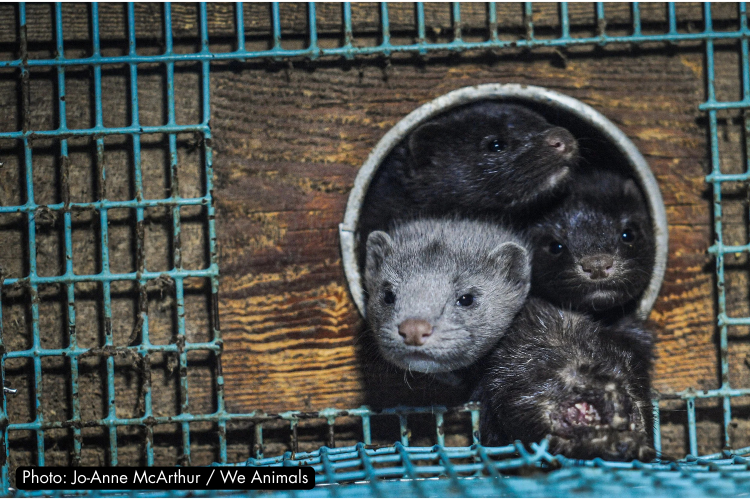The bird flu vaccine just lost US funding, do we still need it?
At the end of May, the Trump administration canceled more than $700 million in funding for the development and testing of a bird flu vaccine (also known as avian influenza or H5N1). This cancellation is just the latest in the administration’s attack on vaccines and does not come as a surprise. However, bird flu and its vaccine is unique for two reasons: its novelty and its origins - both of which are tied directly to modern industrial animal agriculture.
Photo: Jo-Anne McArthur / We Animals
Increased vaccine skepticism and lower vaccination rates have led to diseases that were previously nearly eradicated, such as measles, making a comeback in the United States. This has led some of the more elderly in the United States with memories of measles and other preventable diseases raising the alarm. Bird flu is different. We have not yet experienced a bird flu pandemic, and there is little understanding of how dangerous this disease is. Though there have only been a few cases of humans contracting bird flu, historically it has had a mortality rate of 50%. That means one in two people who have historically contracted bird flu have died (though so far recent cases have been milder). For comparison, this mortality rate is about 30 times higher than COVID-19 pre-vaccine, which had a mortality rate of 1.7%. Funding for a bird flu vaccine marked a positive step forward in terms of vaccine preparedness, as the impacts of COVID-19 are still fresh in the minds of many. However, the vaccine does not address the root of the bird flu problem - animal agriculture.
Animal agriculture is the gasoline fueling the bird flu pandemic. Specifically, the large industrialized form of animal agriculture (aka factory farms), where 99% of animals are farmed, is driving the rapid spread and mutation of the bird flu virus. The USDA Animal and Plant Health Inspection Service and Iowa State University report that the vast majority of eggs in the United States come from large farms of 50,000 to six million hens, with buildings on the farms housing 50,000 to 350,000 hens. To put these abstract numbers in context, this means a large farm houses a population of hens larger than the entire population of Wisconsin, with individual buildings on the farm housing a hen population the size of Madison and Green Bay combined.
Bird flu has compounded the already existing cruelty on these farms. In an effort to contain the virus, producers have resorted to mass killings of flocks. One common way this is done is through suffocation. In some cases, birds are sprayed with firefighting foam until they suffocate. In others, ventilation is shut off and temperatures are raised in houses until the birds die from heat exhaustion, bringing a cruel and inhumane death to thousands of birds in a short period of time. The CDC reports that over 174 million birds have been affected by bird flu so far.
Every time a virus spreads from one host to another it has a chance to mutate. These large poultry farms provide the perfect scenario for the bird flu virus to change and adapt as it spreads to tens of thousands, then hundreds of thousands, then millions of birds on a single farm. One of the reasons bird flu has not received the same attention as viruses like COVID-19 is because it currently has only limited transmissibility to humans. Most of the people who have contracted bird flu so far are those who have prolonged contact with birds - farmers for example. However, each mutation brings with it the risk of increased transmissibility, including to humans and other mammals. This process has already begun, and is accelerating at an alarming rate.
This most recent outbreak of bird flu began spreading among birds in 2020. By 2021, the virus was detected in wild seals, raising alarms for scientists and public health officials. This spread indicated that the virus was mutating to be more transmissible to mammals. Sure enough, in the months and years that followed, additional mammalian species were infected including cats, skunks, rodents, racoons, and more. The most concerning mammalian species to be infected is also the other piece to the agricultural puzzle behind bird flu’s emerging picture - cows.
Dairy cows are not kept in as large numbers as chickens - the average herd size in 2022 was 337. However, this number is skewed by small farms. More than 80% of dairy farms have less than 500 cows, but these farms account for only 25% of the milk produced in the United States. Many dairy farms are much larger, but in any case these farms provide opportunities for the bird flu virus to spread from one cow to another and then spread to the humans who have close contact with them. While the earliest cases of humans infected with bird flu were those who worked on farms with birds, cases among dairy workers have begun to climb with over 600 cow herds infected as of November 2024. Researchers found fragments of the bird flu virus in 20% of commercial milk they sampled, and a study published in the past month found that bird flu can survive in raw milk for up to a week, both providing evidence of the growing threat bird flu poses as it spreads through cows.
For 2025, bird flu cases now appear to be in decline. Experts have varying opinions on why this decline is happening, with some pointing out that bird flu, like the common flu and COVID-19, is seasonal – meaning cases rise and fall naturally. Others suggest that recent cuts to monitoring programs at the USDA and FDA have hampered monitoring, especially of milder cases of bird flu. Taking a step back from this most recent outbreak of bird flu, the seasonality of the virus is apparent, with cases rising and falling periodically since 1997. While this may appear to be positive news, what makes this most recent bird flu outbreak uniquely threatening is the spread of the virus to mammals, which raises the risk of acceleration of spread and mutation.
Cancelling vaccine development funding will most likely cost lives as the specter of a new pandemic is more a question of when than if. However, this is only true if we continue down the path we are currently on with animal agriculture. Right now, vaccine development is a band-aid solution - it is important but does not address the root cause of the problem. Confining thousands of animals in small spaces provides an ideal environment for bird flu to mutate and spread to human hosts. We should develop a vaccine using animal-free testing methods, but more importantly, to protect both human and animal health and prevent the next potentially devastating pandemic, we must abolish animal agriculture, especially factory farming.
Caring about animals means rejecting industries that exploit them for food, fashion, and products. Sign up for the Species Unite 30-Day Plant-Powered challenge to receive free advice, recipes, and support on living without animal products straight to your inbox for an entire month.
Written by Michael Briscoe
Michael Briscoe is an Assistant Professor of Sociology at Colorado State University Pueblo. He is the author of the upcoming book Stocks or Stakeholders: The Benefits of Considering Animal Interests. His research and teaching focus on the interconnections of human, animal, and environmental well-being.
Want to write for Species Unite? We are looking for well-written stories focusing on content that informs, inspires, and engages our audience with topics surrounding animal rights.
We Have A Favor To Ask…
Species Unite amplifies well-researched solutions to some of the most abusive animal industries operating today.
At this crucial moment, with worldwide momentum for change building, it’s vital we share these animal-free solutions with the world - and we need your help.
We’re a nonprofit, and so to keep sharing these solutions, we’re relying on you - with your support, we can continue our essential work in growing a powerful community of animal advocates this year.





